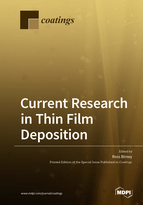Current Research in Thin Film Deposition: Applications, Theory, Processing, and Characterisation
A special issue of Coatings (ISSN 2079-6412). This special issue belongs to the section "Surface Characterization, Deposition and Modification".
Deadline for manuscript submissions: closed (31 August 2020) | Viewed by 46546
Special Issue Editor
Interests: gravitational wave detection; thin film coatings; optics, optical coatings; ion beam technology; tribological coatings; biomedical coatings; vacuum deposition; material characterisation
Special Issues, Collections and Topics in MDPI journals
Special Issue Information
Dear Colleagues,
We invite you to submit your work to this Special Issue, dedicated to recent and current research in the field of vacuum-deposited thin film coatings. Today, thin films are near-ubiquitous and are utilised in a very wide range of industrially and scientifically important areas; from familiar everyday instances such as antireflective coatings on ophthalmic lenses, smartphone optics, photovoltaics, decorative and tool coatings; to somewhat more exotic applications, such as astronomical instrumentation (e.g., ultra-low loss dielectric mirrors and beamsplitters in gravitational wave detectors, such as Laser Interferometer Gravitational-Wave Observatory (LIGO)), gas sensing, medical devices and implants, and accelerator coatings (e.g., coatings for Large Hadron Collider (LHC) and Compact Linear Collider (CLIC) experiments at European Organization for Nuclear Research (CERN)).
The topics of interest for this Special Issue include, but are not limited to:
- Thin film Deposition techniques and technology, e.g., ion beam sputtering, CVD, e-beam, thermal evaporation, magnetron sputtering, ALD;
- Vacuum technology;
- Novel materials for thin film applications, e.g., graphene, stanene, silicene, germanene, nanoparticle coatings, metamaterials;
- New applications for thin film coatings;
- Optical coatings, e.g., for UV, visible, IR, X-ray Bragg mirrors, quantum optics;
- Tribological/barrier/protective coatings, e.g., gas barrier coatings, anticorrosion coatings, antifouling coatings;
- Characterisation of thin film coatings: Methods, techniques and theory;
- Reviews of prior research;
- Biomedical coatings.
Dr. Imogen Birney
Guest Editor
Manuscript Submission Information
Manuscripts should be submitted online at www.mdpi.com by registering and logging in to this website. Once you are registered, click here to go to the submission form. Manuscripts can be submitted until the deadline. All submissions that pass pre-check are peer-reviewed. Accepted papers will be published continuously in the journal (as soon as accepted) and will be listed together on the special issue website. Research articles, review articles as well as short communications are invited. For planned papers, a title and short abstract (about 100 words) can be sent to the Editorial Office for announcement on this website.
Submitted manuscripts should not have been published previously, nor be under consideration for publication elsewhere (except conference proceedings papers). All manuscripts are thoroughly refereed through a single-blind peer-review process. A guide for authors and other relevant information for submission of manuscripts is available on the Instructions for Authors page. Coatings is an international peer-reviewed open access monthly journal published by MDPI.
Please visit the Instructions for Authors page before submitting a manuscript. The Article Processing Charge (APC) for publication in this open access journal is 2600 CHF (Swiss Francs). Submitted papers should be well formatted and use good English. Authors may use MDPI's English editing service prior to publication or during author revisions.






